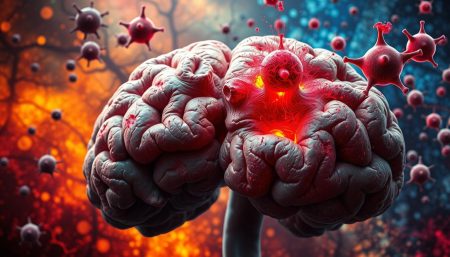For pet owners, their dog’s health is very important. Recognizing Addison’s in canines is a big concern. Addison’s Disease is a serious adrenal insufficiency in dogs that can be dangerous.
Knowing the early signs is key for a quick canine Addison’s disease diagnosis. It helps turn unexplained symptoms into a chance for better health. Let’s learn about Addison’s Disease together, with the help of vets and dog lovers.
Key Takeaways
- Identify the nuanced signals that can indicate Addison’s Disease in pets.
- Grasp the importance of adrenal health for a dog’s overall well-being.
- Appreciate the direct impact of an early and accurate diagnosis on treatment success.
- Learn to spot subtle behavioral changes and physical cues of adrenal insufficiency.
- Empower yourself with knowledge to support and sustain your dog’s health journey.
Understanding Addison’s Disease in Canines
Addison’s disease is a serious condition found in both humans and dogs. It shows up with subtle symptoms that are often misunderstood. In dogs, it affects the adrenal glands, which are key to hormonal balance and health.
What is Addison’s Disease?
The main symptoms of Addison’s disease in dogs are related to low levels of adrenal hormones. These hormones, like cortisol and aldosterone, are crucial for many bodily functions. Spotting early symptoms is vital for treating the disease effectively.
The Role of Adrenal Glands in Your Dog’s Health
The adrenal glands are small but very important organs near the kidneys. They help manage stress and control metabolic processes. Without enough hormones, dogs can face many health problems, showing how crucial these glands are.
Here’s a table to show how Addison’s disease affects adrenal function in dogs:
| Function | Normal Adrenal Activity | Impaired by Addison’s Disease |
|---|---|---|
| Hormonal Production | Cortisol and aldosterone at stable levels | Significantly reduced production |
| Response to Stress | Increases hormone release to manage stress | Insufficient response, leading to increased susceptibility to stress |
| Regulation of Metabolism | Optimal energy utilization | Disrupted metabolic processes, risking hypoglycemia |
| Immune Function | Regulates immune responses | Heightened risk of infections |
By understanding these roles and how they are affected by Addison’s disease, we can better care for dogs. This helps improve their quality of life and life expectancy.
What are the early symptoms of addison’s disease in dogs
Spotting addison’s disease in dogs early is key for their health. Knowing addison’s disease early signs in canines helps keep your pet healthy. Here are the early symptoms to look out for:
- Inconsistent energy levels, also known as lethargy, which can fluctuate quite unpredictably.
- Muscle weakness that makes them less enthusiastic about exercise or play.
- Gastrointestinal issues like loss of appetite, vomiting, and occasional diarrhea.
- Increased thirst and urination, signs that might suggest an imbalance in the body.
- Depression or low mood, which isn’t typical for the dog’s usual behavior.
These symptoms can mean something is wrong. But when they happen together, they point strongly to diagnosing Addison’s disease in dogs. If you see these signs, take your pet to the vet.

The early signs of addison’s disease in dogs can be hard to spot. But catching it early is crucial. It helps avoid a severe crisis that needs quick medical help. So, it’s vital for dog owners to know these signs.
For more on managing and treating this disease, check out medical resources and talk to your vet. Early action can lead to a good treatment plan. This keeps your pet’s life quality high.
Recognizing the Subtle Onset of Addison’s Disease in Dogs
The early signs of Addison’s disease in dogs are often very subtle. They can be mistaken for just a bad day, not a serious health issue. It’s important to watch for these signs closely to catch Addison’s disease early.
Lethargy and Lack of Appetite
Lethargy and a decrease in appetite are common signs of many illnesses. They are also key warning signs for Addison’s disease in dogs. These symptoms can start slowly and may not always be there, making them easy to miss.
But, by paying close attention, you can spot these changes early. This can help in catching the disease before it gets worse.
Gastrointestinal Disturbances in Canines
Gastrointestinal problems like vomiting, diarrhea, or constipation can also be early signs of Addison’s. These symptoms are common in many conditions, making it hard to know if they’re related to Addison’s at first. It’s important to keep an eye on these issues.
They are signs that something is not right in your dog’s body. Watching for these signs closely is key.
If you notice these symptoms in your dog, it’s time to see a vet. Knowing the warning signs of Addison’s disease can help get your dog the right treatment sooner. This can greatly improve their chances of recovery.
Behavioral Changes as Indicators of Canine Addison’s
Spotting canine Addison’s disease often starts with noticing how a dog acts. Changes in mood, energy, and how they interact with their world can be key signs. These signs can help find canine Addison’s disease diagnosis early.

Dogs with Addison’s might seem more stressed or sad. Pets that were once full of life and energy can become very quiet and not want to play. Some might even get angry or aggressive, which is not like them.
- Increased stress
- Depression
- Sudden aggression
These changes in behavior often happen because of the disease’s effects on the body. It can mess with the balance of electrolytes and lower cortisol levels. This can really affect how a dog feels and acts. It’s crucial for owners to watch for these signs as they help spot canine Addison’s.
| Behavioral Change | Possible Reason | Indicator of |
|---|---|---|
| Increased stress | Low cortisol levels affecting mood | Addison’s Disease |
| Depression | Altered adrenal gland function | Canine Addison’s |
| Sudden aggression | Discomfort or pain linked to the disease | Early signs of Addison’s |
Knowing and spotting these changes is key for a quick and right canine Addison’s disease diagnosis. Finding it early means dogs can get the help they need sooner. This can make a big difference in their life quality.
Physical Signs of Addison’s Disease in Dogs
It’s important to know the physical signs of Addison’s disease in dogs. These symptoms can be subtle but show serious health issues. Watching for changes in weight, hydration, and skin is key for early diagnosis and treatment.
Unexplained Weight Loss
One of the most worrying addison’s disease in dogs symptoms is unexplained weight loss. This happens without any change in appetite or diet. It’s a sign of low adrenal hormones, which are vital for body weight.
Dehydration and Poor Skin Elasticity
Dehydration in dogs with Addison’s disease shows as dry gums and skin that doesn’t snap back. These signs are important for owners to watch. If skin doesn’t bounce back, it’s a sign of dehydration, which can make other symptoms worse.
| Symptom | Description | Impact on Dog’s Health |
|---|---|---|
| Unexplained Weight Loss | Loss of body mass without changes in diet. | Can lead to muscle weakness and reduced immunity. |
| Dehydration | Loss of body fluids, leading to dry gums and decreased skin turgor. | Crucial bodily functions can be impaired, and organ failure may occur if not addressed. |
| Poor Skin Elasticity | Skin remains tented when pinched and released. | Sign of severe dehydration and possibly an electrolyte imbalance. |
This table shows how each symptom affects a dog’s health. It highlights the need to not ignore these signs of Addison’s disease. Early detection and vet care can greatly improve management of this condition.
How Gastrointestinal Symptoms Reflect Addison’s in Dogs
Exploring addison’s disease early signs in canines shows how important gut symptoms are. These symptoms are linked to the adrenal glands’ hormone issues. The glands control digestion, among other vital functions. Without enough corticosteroids, like cortisol, dogs often vomit and have diarrhea.
This hormone problem can cause sudden and severe gut symptoms. If not treated quickly, it can lead to bigger health problems. Spotting these signs early can help prevent worse disease effects.
- Increased Frequency of Vomiting: While occasional vomiting might not be a big worry, frequent vomiting is a red flag.
- Intermittent Diarrhea: Diarrhea that comes and goes can also hint at hormonal imbalances in Addison’s disease.
- Appetite Loss: Dogs with Addison’s often don’t want to eat. This is because their digestion isn’t working right.
Spotting these gut signs as possible signs of Addison’s needs careful watching. Pay attention to how often and how bad each symptom is. Catching it early can greatly improve a dog’s chances of managing Addison’s disease.
Identifying Electrolyte Imbalances in Canines
Electrolyte imbalances in dogs, especially with sodium and potassium, are key in detecting Addison’s disease early in dogs. These imbalances are important Addison’s disease warning signs in dogs. They show potential adrenal insufficiency before other symptoms appear.
The Importance of Sodium and Potassium Levels
Sodium and potassium are vital for many body functions. They help with fluid balance, nerve function, and muscle contraction. In dogs with Addison’s disease, hormone production for these electrolytes is often low. This leads to health issues that can be found through blood tests.
How to Detect Electrolyte Imbalances
Vets use blood tests to check electrolyte levels. These tests are key for diagnosing Addison’s disease early. They help manage the condition effectively and on time.
| Electrolyte | Normal Range | Notes |
|---|---|---|
| Potassium | 3.6 – 5.5 mmol/L | High levels may indicate Addison’s Disease |
| Sodium | 135 – 145 mmol/L | Low levels may suggest Addison’s |
Canine Addison’s Disease Diagnosis: A Veterinary Perspective
The canine Addison’s disease diagnosis involves clinical checks, medical history, and special tests. Veterinarians use a detailed method. They know early and correct identifying Addison’s disease in dogs is key for good care.

First, a vet will do a full physical check and look at the dog’s health history. They watch for signs like tiredness, weak muscles, and upset stomachs. Since symptoms can start slowly, it’s easy to confuse it with other issues. So, more detailed tests are needed.
| Diagnostic Tool | Purpose | Relevance to Addison’s Disease |
|---|---|---|
| Biochemical Profile | To evaluate kidney function, electrolytes, and blood sugar levels | Helps detect electrolyte imbalances common in Addison’s |
| Complete Blood Count (CBC) | Assesses overall health and detects anemia | Important for ruling out concurrent infections or other hematologic abnormalities |
| ACTH Stimulation Test | Measures the adrenal glands’ response to the adrenocorticotropic hormone | Considered the gold standard test for diagnosing Addison’s disease |
The ACTH stimulation test is very important for canine Addison’s disease diagnosis. It checks cortisol levels before and after synthetic ACTH. This shows how the adrenal glands work and confirms or denies Addison’s.
Spotting identifying Addison’s disease in dogs is more than just noticing symptoms. It’s about careful testing and watching. Vets work hard to make sure the diagnosis is right. This way, they can treat each dog as an individual. It shows the strong bond between dogs and their owners and their dedication to keeping them healthy.
Effects of Addison’s Disease on a Dog’s Stamina and Strength
When a dog has Addison’s disease, they can’t do things they used to. This is because their adrenal glands don’t work right. The main signs are muscle weakness and not wanting to exercise.
Exercise Intolerance and Muscle Weakness
Dogs with Addison’s disease get tired easily and don’t want to play. At first, they might just get a little tired after playing. But soon, they won’t want to play at all.
They also get weaker because they don’t have enough energy for their muscles. This makes it hard for them to do anything active. It really affects their quality of life.
Assessing Your Dog’s Endurance Levels
It’s important to watch how your dog does when they exercise. You can see how the disease is getting worse over time.
Here’s how you can track your dog’s weakness and tiredness:
- Keep a daily activity log detailing duration and intensity of exercise.
- Note any signs of distress or unusual fatigue during or after activities.
- Monitor and record changes in muscle tone and body condition.
- Seek veterinary advice if a decline in physical performance is observed.
| Activity | Response Before Addison’s Diagnosis | Response After Addison’s Diagnosis |
|---|---|---|
| Short Walks | Energetic and Enthusiastic | Significantly Slower, Possible Rest Stops |
| Fetching Games | Active participation | Less Engagement, Quicker Fatigue |
| Climbing Stairs | Without Difficulty | Shows Reluctance or Difficulty |
By watching how your dog does, you can make their exercise safe and fun. This helps them stay happy and healthy while they’re dealing with Addison’s disease.
Addison’s Disease Warning Signs in Dogs: When to Seek Help
It’s vital to spot the addison’s disease warning signs in dogs early. This can greatly improve your dog’s life quality. Knowing when to seek help for addison’s in canines is key to avoiding serious issues. Here are some signs that mean you should see a vet right away.
- Lack of appetite leading to significant weight loss
- Extreme lethargy or inability to handle stress
- Gastrointestinal issues like vomiting or diarrhea persisting for more than a day
- Weak pulse and irregular heart rate
- Hyperpigmentation of the skin
- Collapse or fainting spells
If your dog shows any of these signs, get vet help fast. Delaying treatment can lead to serious problems, even life-threatening ones.
Early and accurate diagnosis followed by appropriate treatment can greatly enhance the life quality of dogs suffering from this hormonal disorder.
| Warning Sign | Immediate Action Needed |
|---|---|
| Continuous Gastrointestinal Distress | Yes |
| Increased Frequency of Collapses | Yes |
| Sudden Weight Loss | Veterinary Consultation Required |
| Severe Lethargy | Consult Vet Immediately |
Quickly spotting and acting on addison’s disease warning signs in dogs is crucial. Keep a close eye on your dog’s health. Talk to your vet about any unusual signs. Early action and care are vital for a healthy life.

Detecting Addison’s Disease Early in Dogs and Prognosis
Finding Addison’s Disease early in dogs is key to better treatment and care. It means a dog can live a longer, healthier life. Owners and vets can create a strong care plan together.
The Advantage of Early Detection
Finding Addison’s disease early stops serious problems. It helps keep the dog’s health stable. This leads to a better life for the dog and fewer emergency visits to the vet.
Long-term Management of Canine Addison’s
Managing Addison’s disease in dogs for a long time involves medicine and lifestyle changes. Dogs often take daily steroids. Sometimes, they also get fludrocortisone or DOCP shots every month.
- Regular vet visits to check health and adjust meds.
- Keeping the dog’s environment calm to avoid health crises.
- Changing diet and exercise to fit the dog’s energy level.
Managing the disease well is a lifelong job. It requires careful watching of the dog’s health. With the right care, dogs with Addison’s can live a full life.
| Health Management Aspect | Importance | Details |
|---|---|---|
| Medication Compliance | High | Consistent daily hormone replacement is crucial. |
| Regular Vet Visits | High | Essential for monitoring condition and treatment effectiveness. |
| Lifestyle Modifications | Moderate | Helps in reducing stress and maintaining physical health. |
Conclusion
Understanding Addison’s in dogs can be challenging but also rewarding. This article has covered the early signs of Addison’s disease. It aims to help dog owners spot symptoms early.
Being alert to changes in your dog’s health is key. Look out for signs like tiredness, loss of appetite, or unexpected weight loss. Recognizing these signs early is vital for your dog’s well-being.
Early detection of Addison’s disease is crucial. Ignoring the signs can let the disease worsen. This can harm your dog’s quality of life and make treatment harder.
Our goal is to share medical information that helps pet owners. We want to support them in making the best health choices for their pets. We also share inspiring stories of pets and owners beating challenges together.
In summary, spotting Addison’s disease early in dogs is very important. It leads to better care and outcomes for our furry friends. Let’s keep learning and caring for our pets’ health. Their happiness depends on our attention.
FAQ
Q: What is Addison’s Disease in dogs?
A: Addison’s Disease, or hypoadrenocorticism, is a condition where a dog’s adrenal glands don’t make enough hormones. These hormones, like cortisol and aldosterone, help control important body functions and how a dog handles stress. Without enough, a dog’s health can suffer greatly.
Q: Why are the adrenal glands important to my dog’s health?
A: The adrenal glands are key to your dog’s health. They help manage metabolism, blood pressure, and stress through hormones. Without them, your dog can face many health problems.
Q: How can I spot the early symptoms of Addison’s disease in dogs?
A: Early signs of Addison’s in dogs are subtle. Look for lethargy, loss of appetite, and stomach issues. Also, watch for dehydration, a weak pulse, and fainting. Behavioral changes like stress or aggression are signs too. Seeing these signs early is crucial.
Q: What behavioral changes may indicate Addison’s in my dog?
A: Signs of Addison’s include stress, depression, and a lack of interest in activities. Changes in behavior can show physical health issues. If your dog’s behavior changes suddenly, check with your vet.
Q: What are the physical signs of Addison’s Disease in dogs?
A: Look for unexplained weight loss, dehydration, and poor skin. A thin coat and muscle weakness are also signs. These symptoms show the disease’s impact on the body.
Q: Can gastrointestinal symptoms reflect Addison’s in my dog?
A: Yes, symptoms like vomiting and diarrhea are common in Addison’s. These happen because the disease disrupts digestion and absorption. It’s a sign of the disease’s impact on the body.
Q: How are electrolyte imbalances related to Addison’s Disease in dogs?
A: Electrolyte imbalances are a key part of Addison’s Disease. They affect nerve and muscle function. Without proper regulation, dogs can experience weakness and even life-threatening crises.
Q: What tests do veterinarians use to diagnose Addison’s Disease in dogs?
A: Veterinarians use blood tests, like the ACTH stimulation test, to diagnose Addison’s. They also consider your dog’s history and symptoms. This helps confirm the diagnosis.
Q: How does Addison’s Disease affect my dog’s stamina and strength?
A: Addison’s can make dogs tired and weak. They may not want to play or exercise. Hormonal imbalances affect energy and metabolism.
Q: When should I seek help if I suspect my dog has Addison’s Disease?
A: Seek vet help if you see signs like vomiting, lethargy, or dehydration. Timely care is crucial for managing the disease and improving your dog’s life.
Q: What is the benefit of detecting Addison’s Disease early in dogs, and what is the prognosis?
A: Early detection allows for timely treatment and management. With proper care, dogs with Addison’s can live long, healthy lives. Regular medication and vet monitoring are key to a good prognosis.


















